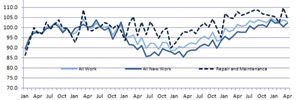New data from the Office of National Statistics (ONS) has shown that despite declines in certain areas of the construction industry in the run-up to the General Election, the industry’s output growth has remained “fairly robust”.
According to the ONS’ latest report for April 2015, construction output fell by 0.8% following the strength of March’s output. This was due to a decline in repair and maintenance work, particularly in the non-housing category, which shrunk by 7.2%. However, construction output was sustained by all new work, which grew by 1.6%. The strongest sub-category of all new work was housing which grew by 5.3% in April 2015, supported by both the public and private sector.
The trend of house-building driving growth within construction has continued for several months, with April’s data suggesting this is still the case. Total new housing showed the largest increase of 5.4%, which is the largest month-on-month increase since January 2014 when it increased by 5.8%. The level of total housing at œ2.5 billion is the highest since the monthly series began in January 2010.
The fall in total work throughout April is thought to be a result of uncertainty surrounding May’s General election, with subsequent data suggesting the industry has begun to recover.
Dr Noble Francis, economics director at the Construction Products Association (CPA), said: “Total construction output fell slightly in April but this was expected due to the uncertainty prior to the General Election and its adverse impacts on consumer and business confidence. Specifically, this influenced the kinds of construction work that can be temporarily delayed such as repairs, maintenance and improvements work. New construction work was affected to a lesser extent and, despite election uncertainty, private housing output was 4.5% higher than in March and 16.6% higher than one year earlier.
However, annual data suggests that the industry is still in a period of long-term growth, with April 2015 showing a 1.5% increase in output compared to the same month in 2014. This reflects an easing in growth compared to the peak of 11.2% recorded in December 2014 but remains in positive territory and is consistent with the Bank of England’s assessment that the construction industry’s growth remains fairly robust.

Chris Temple, engineering and construction leader at PricewaterhouseCoopers, said: “We continue to expect the sector to show solid, healthy growth during 2015. In the run-up to the general election we saw a temporary slowdown in new orders. However, we don’t expect that this will be significant enough to counteract the upward trend of growth for the year, and there is still strong confidence in the sector for 2015 and beyond.
“We’re confident that this temporary slowdown won’t become a longer-term trend, and our clients are optimistic for their growth prospects in the rest of 2015. Overall the picture for the construction sector remains healthy.”
In recent months, ONS figures showing decline in construction have attracted criticism for not being representative of the industry’s true performance. In May 2015, the CPA criticised ONS data for not reflecting the reports it had received from construction firms enjoying growth. Following consultation with the CPA, ONS said it had changed the way it calculates price changes in the construction sector and its method for seasonal adjustments to the data. Construction output in the first quarter of 2015 was then revised to show a fall of 0.2%, a weaker decline than a fall of 1.1% previously reporte




